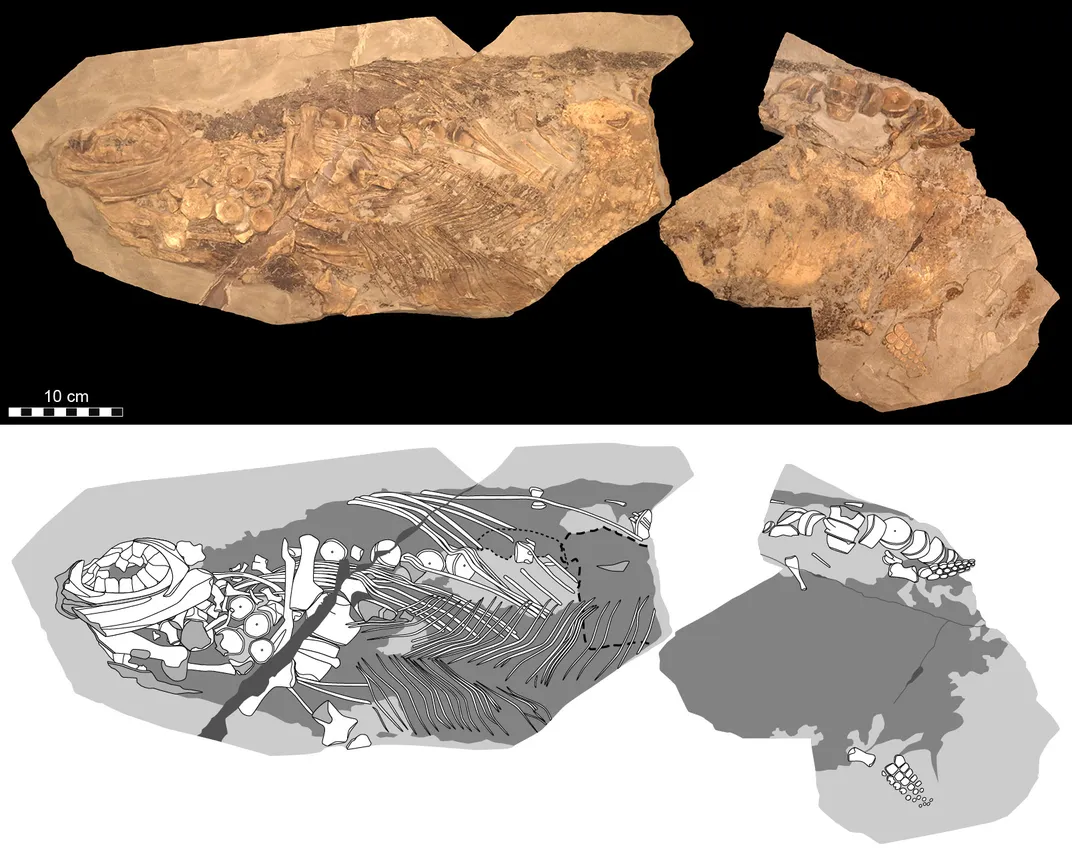Like Whales and Dolphins, Prehistoric ‘Fish Lizards’ Kept Warm With Blubber
A new analysis of a pristine ichthyosaur fossil reveals that the prehistoric marine reptile had a layer of insulating fatty tissue
:focal(1000x809:1001x810)/https://tf-cmsv2-smithsonianmag-media.s3.amazonaws.com/filer/60/25/6025e674-4b16-4184-a74d-fb1523234b0d/ebtykf.jpg)
Ichthyosaurs are a classic case of convergent evolution. From their body shapes to their fish-snatching lifestyles, they pioneered a way of life in the seas that would much later be replicated by dolphins. And now, an in-depth study of an exceptional ichthyosaur fossil has added new points of similarity between the marine reptiles of the past and the cetaceans of our modern seas, including a fatty, insulating layer of tissue called blubber.
Published in Nature today, the new study by North Carolina State University biologist Mary Schweitzer and colleagues focuses on a special fossil known to experts as MH 432. It’s an exceptional specimen of an ichthyosaur called Stenopterygius found in the roughly 178 million-year-old strata of Holzmaden, Germany.
“When I look for a specimen to study, one of my first criteria is that it shows some sign of unusual preservation,” Schweitzer says. In the case of MH 432, that unusual preservation came in the form of remnants of soft tissues surrounding the bones. This fossilized tissue raised the question of how much fine detail the specimen might preserve, down to the molecular level. “This is probably the most in-depth and variable, cross-disciplinary, chemical and molecular analysis conducted on any fossil specimen that I am aware of,” Schweitzer says.

What the research team found came as a surprise. Molecular analysis of fossils from marine environments previously hadn’t turned up any promising results, Schweitzer says. But in this case, the paleontologists found a wealth of information, from signs of the ichthyosaur’s skin shading to evidence that these marine reptiles were active, warm-blooded swimmers.
The analysis considered Stenopterygius from the inside out. “The possibility of reconstructing coloration patterns in extinct organisms is one of the most exciting recent developments in paleontology,” Vanderbilt University paleontologist Neil Kelley says. “To my knowledge, this is the first reported evidence for countershading in ichthyosaurs.” Thanks to the presence of pigment-carrying cells called chromatophores, the research team found that this Stenopterygius likely had dark shading above and light shading below to help blend in with its ocean environment.
Working through the preserved soft tissue layers of the fossil, Schweitzer and colleagues also found evidence of a fatty layer beneath this skin. Many marine mammals, leatherback sea turtles, and penguins have similar deposits, Kelley says, and the blubber is tied to elevated metabolism and body temperatures to keep the animal warmer than the surrounding environment. This finding tracks with previous research that suggested another species of marine reptile internally regulated its body temperature, and it is consistent with the idea that “some ichthyosaurs were probably deep divers and would have needed to conserve energy and elevated temperatures to perform in cold, dark waters,” Kelley says.
/https://tf-cmsv2-smithsonianmag-media.s3.amazonaws.com/filer/5e/ed/5eed4fbb-0e24-4bb7-b513-eda8b716b413/image-two-1.jpg)
The evidence that Stenopterygius had blubber is a further confirmation that ichthyosaurs maintained elevated body temperatures and were extremely active. “Blubber is expensive,” Schweitzer says. “The only animals that produce it use it to retain body heat above environmental levels, and the only animals that need to do that are ones that generate heat in the first place.” This internal body heating is a further point of similarity between ichthyosaurs and today’s dolphins, whales and porpoises. The ancient marine reptiles and modern marine mammals don’t just look like each other, but they independently evolved similarities that went more than skin deep.
“The discovery of ichthyosaurs with soft-tissue outlines really revolutionized our understanding of them as animals all the way back in the 19th century,” Kelley says. “So, it is very exciting and timely to see them applying such a wide swatch of cutting-edge tools to literally flesh out these extinct animals.” This study is the closest look at ichthyosaur anatomy and biology that’s yet been assembled.
Of course, the implications of these findings extend beyond ichthyosaurs. While paleontologists used to ask if fossil preservation could go down to the molecular level, now experts are using a variety of techniques to identify and analyze these microscopic clues. “I think it shows what we can know from ancient fossils,” Schweitzer says. And “that it is a lot more than we previously thought.”
/https://tf-cmsv2-smithsonianmag-media.s3.amazonaws.com/accounts/headshot/RileyBlack.png)
/https://tf-cmsv2-smithsonianmag-media.s3.amazonaws.com/accounts/headshot/RileyBlack.png)